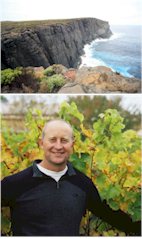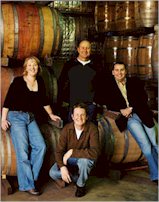


Within the Great Southern wine region is a collection of five sub regions, each with their own unique topographical qualities. These regions include Denmark, Albany, Porongurup, Mount Barker and Frankland River. With a typical maritime climate, the coastal towns of Denmark and Albany experience relatively mild summer temperatures and cool wet winters. These conditions enable fruit to ripen slowly and gradually, thus developing subtle layers of fruit intensity and are well suited to the earlier ripening varieties such as Chardonnay, Pinot Noir and Merlot. Further inland to Mount Barker, Porongurup and Frankland River, the days are slightly warmer, and the nights are cooler (with a higher risk of frosts). With greater sunshine hours, these sub-regions are where Riesling, Chardonnay, Cabernet Sauvignon and Shiraz varieties thrive.

Situated 450 kilometres south of Perth, the coastline of Denmark rates among the most beautiful in the South-west. Denmark is commonly dubbed the town where the forest meets the sea. Towering eucalyptus including karri, marri and jarrah trees along with pristine, blue coastal bays, makes Denmark the perfect playground for bushwalking, fishing, surfing, swimming, snorkelling and boating.
Just a stone's throw away from the picturesque township of Denmark, West Cape Howe is one of the most southerly points, rising some 250 metres above the Southern Ocean. It is thought that the first explorers to the Cape Howe coastline were Dutch seafarers in 1627 aboard their Fluyt class vessel Gulden Zeepaard (Golden Seahorse). The rugged coastline is now home to some stunning beaches and great rock climbing sites.
It is for this reason that the West Cape Howe winemakers dedicate many months leading up to vintage, visiting and monitoring vineyards throughout the Great Southern region - ensuring that only the best parcels of fruit are selected and picked for the West Cape Howe range of wines.

The sourcing of this fruit from specific vineyards, and in many cases specific blocks on the vineyard, is one of the most important factors in the production of West Cape Howe wines. The Landsdale Vineyard, located just outside the township of Mount Barker, Western Australia, provides the winery with the majority of the fruit. Planted in 1989, the Landsdale Vineyards are some of the most mature in the Great Southern, with some 80 hectares under vine. Premium fruit is also sourced from areas such as Denmark, Albany, Bridgetown and Boyup Brook.
With passionate winemakers and innovative wine styles, the stunning range of West Cape Howe wines demonstrates the exciting diversity of this unique region and is sure to impress.
The Great Southern Range, elegant and vibrant, showcases the outstanding potential of the region in producing world class wines and styles. Limited in production, these wines are regularly applauded through outstanding wine reviews and awards from local and international wine shows.
Zeepaard is West Cape Howe's new export wine, named after the "Gulden Zeepaard" (the Dutch word for Golden Seahorses) found on our award winning logo. The Zeepaard range of wines are fresh, contemporary in style and distinctly varietal in flavour designed for immediate enjoyment.
